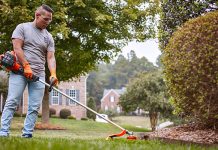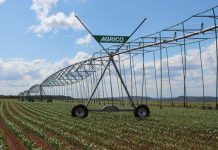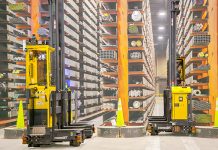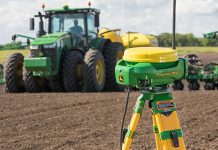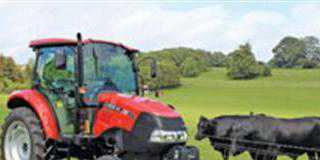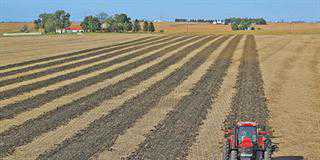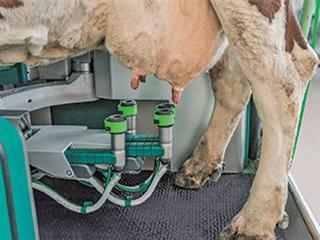
GEA Farm Technologies’ DairyProQ Milking Place Module
Designed for carousel, herringbone or side-by-side milking parlours, GEA’s DairyProQ is an intelligent modular system for semi-automatic or fully-automatic milking of dairy cows. The module carries out all the steps in the milking process, virtually eliminating manual labour-related problems. The DairyProQ implements cow teat preparation, including pre-milking teat dipping and teat stimulation, and extracts a preliminary milk sample from the udder. It then carries out the milking and post-milking teat dipping processes before removing the milking cluster from the cow.
Before starting the entire process again with the next cow, the DairyProQ disinfects the teat cups and their external components to prevent milk or udder cross-contamination. “The unique feature of the milking stall module is the complete automation of the process in one comprehensive system,” says GEA.
“The individual stall solution gives a dairy manager free access to the animal and the udder at any time during the milking process, guaranteeing the reliability of the system. The milking stall module is also available as a semi-automatic version.”
GEA adds that larger dairy operations can operate the technology without having to implement major changes to their normal dairy processes and procedures. Moreover, the savings on labour costs can be used to refine and improve other aspects of the dairy operation.
Email: [email protected] or visit www.gea-farmtechnologies.com
Alternatively, visit www.youtube.com and type in the search phrase “GEA Farm Technologies – DairyProQ” or click on www.youtube.com/watch?v=KwjKng9gfes&list=PLC919A5B51E573557&index=19
Marel Stork Poultry Processing – optimising broiler scalding
Conventional scalding of broiler carcasses typically features a series of scalding tanks. To optimise the process, compressed air is injected into the water. As the Netherlands-based Marel Stork Poultry Processing company points out, however, this requires a large volume of water and results in high power consumption. It can also cause cross-contamination of carcasses.

Photo courtesy of Marel Stork Poultry Processing
Marel Stork Poultry Processing’s AeroScalder system claims to overcome these problems by blowing moisturised hot air at high pressure over the carcasses. “This saves up to 75% on water use and up to 50% on power consumption,” the manufacturer explains. “And because the air/water mixture is generated next to the spray chamber, the system requires less space than normal carcass- scalding machinery.”
The AeroScalder is enclosed and consists of two chambers. The hot, moist air is prepared in the first chamber, and the scalding takes place in the second (see below). The air separates the feathers, transferring heat effectively and evenly, and preventing over-scalding. The air temperature can be set for hard, medium or soft scalding. The used air is then sucked back, reheated and recirculated.
Contact 011 823 6940, email [email protected] or visit www.marel.com/poultry.
ITIN + HOCH’s RumiWatchSystem for automatic health monitoring in ruminants
The Swiss company ITIN + HOCH, together with the country’s Agroscope Reckenholz-Tänikon Research Station, has developed the RumiWatchSystem (RWS) to enable livestock farmers, veterinarians and scientists to generate accurate, up-to-date and easy-to-understand computerised readings of a ruminant’s health. The RWS consists of a noseband sensor attached to a halter that registers all the animal’s jaw movements.
The animal is also fitted with a pedometer to record its physical activity or lack thereof. The data collected is transmitted wirelessly to a receiver linked to the farmer’s computer. RumiWatch Manager software translates all the data into an easily readable format. By recording an animal’s jaw movements at a rate of 10 signals per second, the noseband sensor monitors the animal’s eating, drinking and rumination. Reduced chewing per bolus per animal is an indication of digestive disturbance or a problem with the ration, and appropriate action can be taken.
“The unique feature of the noseband sensor is its ability to register and measure every single bolus, jaw movement
or drink gulp,” ITIN + HOCH explains. “The pedometer consists of an acceleration sensor and wireless transmitter that generates a summary of the time the animal spends lying down, standing or walking.” The RumiWatchSystem also features an alarm function that activates when the herd or individual animals exceed pre-determined threshold values. This helps farmers to diagnose problems early and respond to critical conditions, in turn reducing production losses and ensuring more reliable production.
Email: [email protected] or visit www.fuetterungstechnik.ch/rumi-watch.html
For a scientific report, visit the following link:
OptiSCAN: a handheld pig-weighing system from Hölscher + Leuschner
German company Hölscher + Leuschner’s optiSCAN is a mobile handheld system for weighing fattening pigs. The handy device incorporates 3D camera technology and is held over a pig for three seconds. A 3D picture and co-ordinates are then produced automatically and these digitally determine the pig’s weight. The optiSCAN eliminates the strenuous, time-consuming pig-weighing process. It improves labour management and causes no unnecessary stress to the animals.
.gif)
The optiSCAN’s mobility and convenience enables instant and accurate weighing, reducing unnecessary stress to the pigs and saving time. Images courtesy of Hölscher + Leuschner
A quick scan with the optiSCAN enables more precise, weight-related marketing and a faster, more animal-friendly weighing operation. It also eliminates the work associated with conventional weighing, such as cleaning the driving passages and weighing platforms. This in turn saves water and disinfectants.
For more information, email c[email protected] or visit www.hl-agrar.de
Hölscher + Leuschner’s optiCOW features a 3D imaging system for automatic cow body condition scoring
German company Hölscher + Leuschner won a second EuroTier 2012 Gold Medal for its optiCOW technology, which automatically evaluates a cow’s body condition score. OptiCOW uses radio frequency identification to identify individual dairy cows as they pass in or out of the milking parlour. Each cow is recorded with a 3D camera and her weight is automatically recorded as she passes over a scale. A computer programme uses the data to produce a 3D image of the cow’s hindquarters and calculates her body condition score.
The farmer can use this information to make management decisions on individual animals or the entire herd. The system is easily integrated into an existing milking parlour. The system measures a cow in only about five seconds and does not interrupt the normal milking process. The software programme is logical and easy to learn and operate, according to Hölscher + Leuschner.
This image-processing technology continuously shows the fat mobilisation dynamics for each cow during lactation. OptiCOW provides accurate information on the health and physical condition of each cow and enables the farmer to better control the milk yield capacity of the herd through feeding and herd management.
For more information, email [email protected] or visit www.hl-agrar.de


